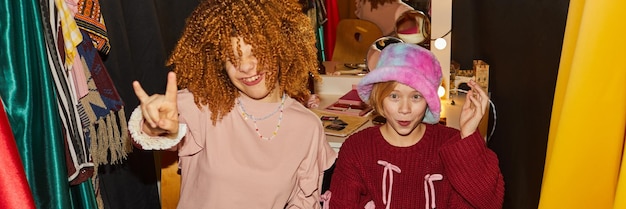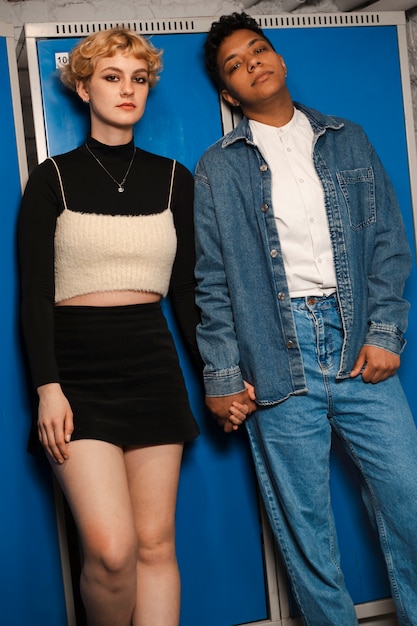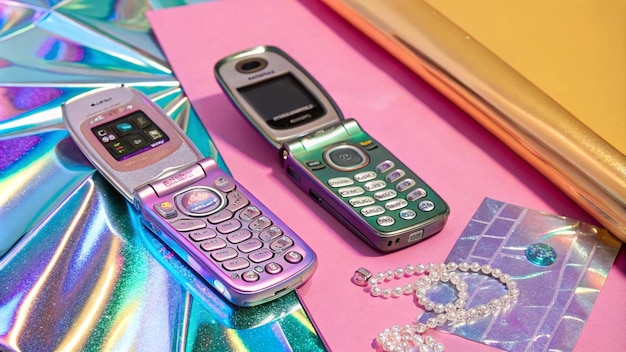Nostalgia Marketing Boom: 90s Trends Making a Comeback in the US

Nostalgia marketing is experiencing a significant surge, particularly in the US, with numerous trends from the 90s, including fashion, entertainment, and technology, being revived and adapted to appeal to modern consumers seeking a connection to their past.
The resurgence of 90s trends is not just a fleeting fad; nostalgia marketing is capitalizing on a deep-seated longing for simpler times, and US consumers are eagerly embracing the revival of iconic fashion, entertainment, and technology.
Why is Nostalgia Marketing So Effective?
Nostalgia marketing has proven to be a potent strategy, tapping into emotions and memories associated with past eras. Understanding why this approach resonates so strongly with consumers, especially in the context of revived 90s trends, is key to appreciating its effectiveness.
The Psychology Behind Nostalgia
Nostalgia is more than just reminiscing about the past; it serves a psychological function. It can provide comfort, reduce anxiety, and enhance feelings of social connectedness, especially during times of uncertainty or rapid change.
Emotional Connection and Brand Loyalty
Brands that effectively leverage nostalgia create emotional connections with their audience. By evoking positive memories, they foster a sense of trust and loyalty, encouraging repeat purchases and strengthening brand advocacy.
- Comfort and Security: Nostalgia offers a sense of comfort and security, reminding consumers of simpler, less stressful times.
- Positive Associations: The 90s are often associated with positive memories of childhood, adolescence, and cultural milestones.
- Differentiation: Nostalgia marketing can help brands stand out in a crowded marketplace by offering a unique and emotionally resonant message.
The effectiveness of nostalgia marketing lies in its ability to evoke powerful emotions and create meaningful connections between brands and consumers. By tapping into the fond memories associated with the 90s, marketers are able to resonate deeply with their target audience and drive engagement.
Iconic 90s Fashion Trends Making a Comeback
Fashion trends from the 90s are experiencing a significant resurgence, captivating a new generation of style enthusiasts while also rekindling fond memories for those who lived through the era. From grunge to minimalist chic, the decade’s most iconic looks are back in vogue.

The Return of Grunge
Grunge fashion, characterized by oversized flannels, ripped jeans, and combat boots, is making a bold comeback. This anti-establishment style, popularized by bands like Nirvana, resonates with those seeking authenticity and individuality.
Minimalist Chic
On the opposite end of the spectrum, minimalist chic, with its sleek lines, neutral colors, and slip dresses, is also enjoying a revival. This understated elegance appeals to those who appreciate timeless and sophisticated style.
- Chokers: These defining accessories of the 90s are back, adding a touch of edginess to modern outfits.
- Crop Tops: From basic tees to fitted tanks, crop tops are a staple in contemporary fashion.
- High-Waisted Jeans: Offering comfort and style, high-waisted jeans are a versatile option that complements various body types.
The revival of 90s fashion trends reflects a broader desire for self-expression and individuality. As consumers seek unique ways to express their personalities, the iconic styles of the 90s provide a rich source of inspiration.
90s Entertainment: From TV Shows to Music
The entertainment landscape of the 90s was defined by iconic TV shows, groundbreaking music, and innovative technology. Today, many of these elements are experiencing a resurgence, captivating audiences with their nostalgic appeal.
TV Shows That Defined a Generation
Shows like “Friends,” “Seinfeld,” and “The Fresh Prince of Bel-Air” continue to be popular, thanks to streaming services and syndication. Their relatable characters and timeless storylines resonate with viewers of all ages.
The Rise of 90s Music
From grunge and alternative rock to hip-hop and pop, the 90s produced a diverse range of musical genres that continue to influence contemporary artists. Bands like Nirvana, Spice Girls, and Backstreet Boys remain iconic and influential.
- Streaming Services: The availability of classic 90s TV shows and music on streaming platforms has fueled their resurgence in popularity.
- Remakes and Reboots: Many iconic 90s TV shows and movies are being remade or rebooted for modern audiences, introducing them to a new generation of fans.
- Soundtracks and Compilations: The soundtracks and compilation albums from 90s movies and TV shows continue to be popular, preserving the musical legacy of the era.
The enduring appeal of 90s entertainment underscores the power of nostalgia and its ability to transcend generations. By revisiting the iconic TV shows, music, and movies of the decade, audiences can relive cherished memories and discover timeless classics.
The Tech of the 90s: Gadgets and Gizmos Reimagined
The 1990s were a pivotal era for technological innovation, marked by the rise of personal computers, the internet, and portable gadgets. Many of these technologies are being reimagined and adapted for the modern age, tapping into consumers’ nostalgia for simpler, less connected times.
The Return of Classic Gaming Consoles
Consoles like the Nintendo 64 and PlayStation are experiencing a resurgence, thanks to retro gaming emulators and mini-consoles that allow users to play classic games on modern devices. These consoles offer a nostalgic escape for gamers who grew up in the 90s.
Polaroid Cameras and Instant Photography
The rise of digital photography may have diminished the popularity of instant cameras for a time, they are now experiencing a resurgence, fueled by nostalgia and the desire for tangible memories. Modern Polaroid cameras offer a unique blend of vintage aesthetics and contemporary technology.

- Tamagotchis: These virtual pets are back, offering a nostalgic experience for those who remember caring for them in the 90s.
- Retro-Inspired Designs: Modern tech gadgets are often designed with retro aesthetics, harking back to the iconic designs of the 90s.
- Nostalgic Apps and Software: Many apps and software programs are designed with a 90s-inspired interface, offering a nostalgic user experience.
The reimagining of 90s tech gadgets and gizmos reflects a broader trend of nostalgia in the technology industry. By blending vintage aesthetics with modern functionality, tech companies are able to capture the attention of consumers seeking a connection to the past.
Nostalgic Marketing Campaigns: Brands That Nail It
Several brands have successfully leveraged nostalgia marketing to connect with their audience and drive consumer engagement. These campaigns often feature iconic imagery, characters, and slogans from the 90s, evoking powerful emotions and memories.
Pepsi’s Throwback Cans
Pepsi has released throwback cans featuring its classic 90s logo, appealing to consumers’ nostalgia for the decade. This simple yet effective campaign has generated significant buzz and driven sales.
McDonald’s Retro Happy Meals
McDonald’s has offered retro Happy Meals featuring classic toys and characters from the 90s, tapping into consumers’ fond memories of childhood. These limited-edition Happy Meals have been a hit with both kids and adults.
- Iconic Imagery: Effective nostalgia marketing campaigns often feature iconic imagery, characters, and slogans from the targeted era.
- Limited-Edition Products: Limited-edition throwback products can create a sense of urgency and exclusivity, driving consumer demand.
- Social Media Engagement: Brands can leverage social media to encourage consumers to share their nostalgic memories and experiences, amplifying the reach and impact of their campaigns.
The success of these nostalgia marketing campaigns demonstrates the power of emotional connection in branding. By tapping into consumers’ fond memories of the 90s, brands can create meaningful and lasting relationships with their target audience.
Potential Pitfalls of Nostalgia Marketing
While nostalgia marketing can be a powerful strategy, it is not without its potential pitfalls. Brands must be careful to avoid alienating their audience or creating a disconnect between their nostalgic message and their current brand identity.
Authenticity and Relevance
Nostalgia marketing campaigns must be authentic and relevant to the brand’s values and target audience. If the campaign feels forced or inauthentic, it can backfire and damage the brand’s reputation.
Exclusion and Generational Divide
Nostalgia marketing campaigns that focus too narrowly on a specific era or generation may exclude other segments of the population. Brands must be mindful of inclusivity and avoid alienating potential customers.
- Over-reliance on Nostalgia: Brands should not rely solely on nostalgia marketing. It is important to balance nostalgic appeals with contemporary messaging and innovation.
- Misinterpretation of Trends: Brands must carefully research and understand the nuances of the targeted era to avoid misinterpreting trends or cultural references.
- Potential for Negative Associations: Brands must be aware of any negative associations that may be associated with the targeted era and take steps to avoid them.
To avoid these pitfalls, brands must approach nostalgia marketing with careful planning and execution. By ensuring authenticity, relevance, and inclusivity, they can effectively leverage nostalgia to connect with their audience and drive positive results.
| Key Point | Brief Description |
|---|---|
| 🎮 90s Tech Revival | Classic consoles like Nintendo 64 are making a comeback. |
| 🎵 Music Resurgence | 90s music genres like grunge heavily influence modern hits. |
| 👗 Fashion Comeback | Trends like chokers and crop tops are trending again. |
| 📺 TV Shows Endure | Beloved 90s shows like “Friends” remain widely popular on streaming platforms. |
Frequently Asked Questions
▼
The popularity of 90s trends is largely attributed to nostalgia, offering a sense of comfort and familiarity during uncertain times. The decade is remembered fondly, influencing current fashion, music, and tech trends.
▼
Several 90s fashion trends are back. These include high-waisted jeans, crop tops, chokers, slip dresses, and grunge-inspired looks with oversized flannels and combat boots.
▼
Companies use nostalgia marketing by reintroducing classic products, featuring 90s imagery in ads, or creating limited-edition throwback items. Often, they evoke feelings of happiness and simplicity associated with the decade.
▼
Yes, risks include alienating younger audiences, misinterpreting trends, or seeming inauthentic. Marketers should balance nostalgia with modern appeals to avoid feeling dated or tone-deaf.
▼
Retro gaming consoles like the Nintendo 64, instant cameras (like Polaroids), and virtual pets (Tamagotchis) are experiencing a revival. Modern updates blend vintage aesthetics with contemporary functionality.
Conclusion
The boom in nostalgia marketing, particularly with the resurgence of 90s trends, highlights a powerful connection between consumers and their past. By understanding the psychology behind nostalgia and carefully leveraging iconic elements from the decade, brands can create meaningful campaigns that resonate deeply, fostering brand loyalty and driving engagement. However, authenticity and relevance are key to avoiding potential pitfalls and ensuring that nostalgic appeals complement, rather than overshadow, a brand’s contemporary identity.
